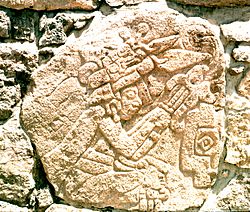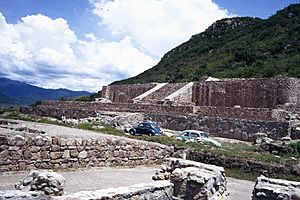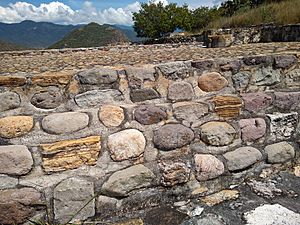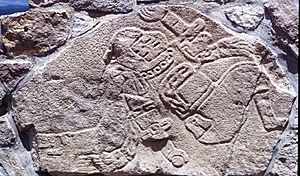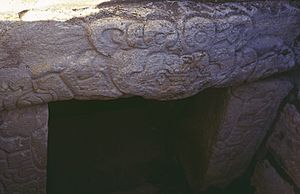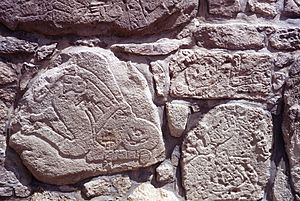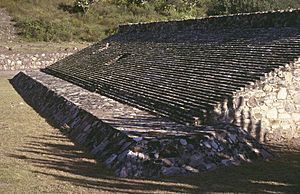Dainzú facts for kids
| Name: | Dainzú |
| Location | Valle de Tlacolula, Oaxaca |
| Coordinates | 17°0′13″N 96°33′25″W / 17.00361°N 96.55694°W |
| Culture | Zapotec |
| Period | Mesoamerican Preclassical & Classical |
| Foundation | Around 700 BCE. |
| Decline | Classical period, 300 CE |
| Language | Zapotec |
| INAH Official Page | Dainzú Archaeological Site – INAH |
Dainzú is an ancient Zapotec city in Oaxaca, Mexico. It's about 20 kilometers (12 miles) southeast of Oaxaca City. This archaeological site is very old, even older than the famous city of Monte Albán.
People first lived at Dainzú around 700-600 BC. The city was most active from about 200 BC to 350 AD. A Mexican archaeologist named Ignacio Bernal first explored and dug up the site in 1965.
Contents
What Does "Dainzú" Mean?
We don't know the original name of this ancient city. The name "Dainzú" comes from the word Dannizhú. Local people used this word when archaeologist Ignacio Bernal was asking about the site.
In the Zapotec language, "Dainzú" means "hill of the organ cactus." It combines two Zapotec words: danni for "hill" and zu for "organ cactus."
Another name for the site was "Quiabelagayo." This Zapotec word means "Five Flowers." This name is also linked to the nearby town of Macuilxochitl.
The History of Dainzú
Dainzú was likely settled before Monte Albán was founded. Pottery found there shows people lived in the area from 700 to 500 BCE. At that time, Dainzú was a major village in the Tlacolula Valley. It was as important as other centers like San José Mogote.
Many villages, including Dainzú, probably helped found Monte Albán. After Monte Albán became a big city, Dainzú's population went down around 200 BCE. But Dainzú still remained an important city during the Classical Mesoamerican period. When Monte Albán started to decline, it also affected Dainzú, leading to its decline.
Archaeologists have found many ancient sites along the Rio Salado river. This includes the early village of Abasolo. On the west side of Dainzú, there's rich farmland. Pottery from the Rosario Phase (around 750 BCE) confirms that Dainzú was occupied very early.
Exploring the Dainzú Archaeological Site
Dainzú has a unique architectural style. Its buildings are different from others in the Valley of Oaxaca. They show high artistic skill. For example, the lower part of Building A has a gallery of stone carvings. These carvings are thought to show ancient ballgame players.
During its main period, Dainzú was a significant city. It was important for trade, politics, and religion. The most active time for the city was from about 250 to 350 CE.
Dainzú was built against a hill. Its original entrance was likely on the side facing the river. The city was lived in for a long time, from 600 BCE to 1200 CE. However, its most important period was from 600 BCE to 200 CE. Steps and rooms carved into the rock on the hill above might have been part of a special shrine.
Important Structures at Dainzú
The builders of Dainzú used stones from the river. These were mostly volcanic rocks like basalt. All the buildings were designed to fit the natural shape of the land.
So far, archaeologists have explored three main structures:
Building A: The Sculpture Gallery
Building A is at the highest part of the site. It was probably used for religious ceremonies. It has four platforms built with stones and clay. The most interesting part is the carvings on the south wall of the lowest platform. This area is called the sculpture gallery.
Each stone carving shows figures in motion. No two carvings are exactly alike. Archaeologist Ignacio Bernal believed these carvings show ballgame players in action. They might have been added during a rebuilding of the platform.
This structure is a large platform built into the hillside. It has about 35 stone carvings on its lower wall. Most show ball-players wearing helmets and knee-guards. Four carvings show gods related to the ballgame. Some carvings also show priests making offerings. These stones have calendrical dates carved into them. They might show specific rituals for the ballgame.
Building A is the oldest terrace. Its building style is similar to Building J at Monte Albán. It has three terraces stacked on the hill. A stucco-covered patio connects it to Building B. It has two main sides (north and south) with a large staircase in the middle.
The top terrace is the highest. It has a tall, almost vertical wall with rounded corners. You could enter it through a covered passage with steps. Inside, four rooms were found. Their roofs were made of large stones placed at an angle, like some tombs in Monte Albán.
The lower terrace has a 1.25-meter (4-foot) vertical wall. You can enter it using a stairway built into the wall. The carvings on the north side are different from the others. This terrace also has a central stairway. Over time, changes were made to the building. Rooms, stairways, and walls were added to repair damage and change its use.
Unique Bas-Reliefs Gallery
These stone carvings are special and unique in Mesoamerica. They show important religious leaders and ball players. The players are holding a small ball in one hand.
The site has 47 such carvings. They show ball-players wearing protective gear. This includes helmets, knee-guards, and special gloves. A large ball-court was found nearby. It runs from east to west.
More carvings are found on the natural rock of the hilltop shrine. The presence of skulls in some carvings might show the deep meaning of the game.
Building B: Tombs and Patios
Building B is located west of Building A. It's a huge structure with many rooms, stairways, and patios. These parts were built at different times. This building has an important tomb with a jaguar carving. The jaguar's head is carved above the entrance, and its front paws are on either side.
The simple design and open spaces suggest that this building was used for public gatherings. You enter this building through a staircase from the bottom terrace or plaza. This staircase leads to a covered hallway with large stone slabs for a roof.
Originally, this complex had two separate terraces. They were connected by the "Templo Amarillo" (Yellow Temple). There are also underground channels to drain rainwater. These channels are well-built with a rectangular shape.
Inside the terraces, archaeologists found four burial chambers and several simpler tombs. The most important tomb, called Tomb 7, was completely private. You could access it through a stairway.
Tomb 7: The Jaguar Entrance
Tomb 7 was built in the middle of Building B. Its walls have carved stones and niches. The roof is made from a single large stone. The entrance has a jaguar figure. The jaguar's head is carved into the stone above the door, and its front paws are on either side.
This tomb was likely robbed a long time ago, perhaps even before the Spanish arrived. Because of this, it is partly damaged. Tomb 7 dates back to the Monte Albán II-III A period (200 to 600 CE).
Templo Amarillo: The Yellow Temple
This is a small building made of adobe and stone inside Building B. It was probably an altar built on a stucco-covered platform. It faces a small patio to the west. The entrance has two round columns, like those seen in Monte Albán. A rectangular niche was found on the right side. The entire building was painted yellow. Its direction might have had a religious meaning.
Group C
This structure is connected to the south side of Group B. It's about the same height. It's a small terrace that connects to Group D, which has not been dug up yet.
The Ancient Ballgame Court
Only half of the ballgame court has been dug up and restored. It has small stone blocks that look like steps. These were covered with stucco to create a sloped playing surface.
The court is in the middle of a large square. It is shaped like an "I," similar to ballgame courts at Monte Albán and Yagul. It faces east to west, which is common for Mesoamerican ballgame courts.
During the excavation, stone carvings of ballgame players were found. This shows how important this game was for rituals in the area. The court was built with carved, uneven stones joined with clay and small pebbles. It was then covered with a thin layer of stucco.
The players wore special clothing. This included pants, knee pads, face masks or helmets shaped like felines, and other items.
At Dainzú, two types of ballgame are shown. Older carvings show players using gloves to catch, hit, or throw the ball. A later version of the game, played in the I-shaped courts, involved hitting the ball with the hips. This later game is known as olomaliztli.
See also
 In Spanish: Dainzú para niños
In Spanish: Dainzú para niños



